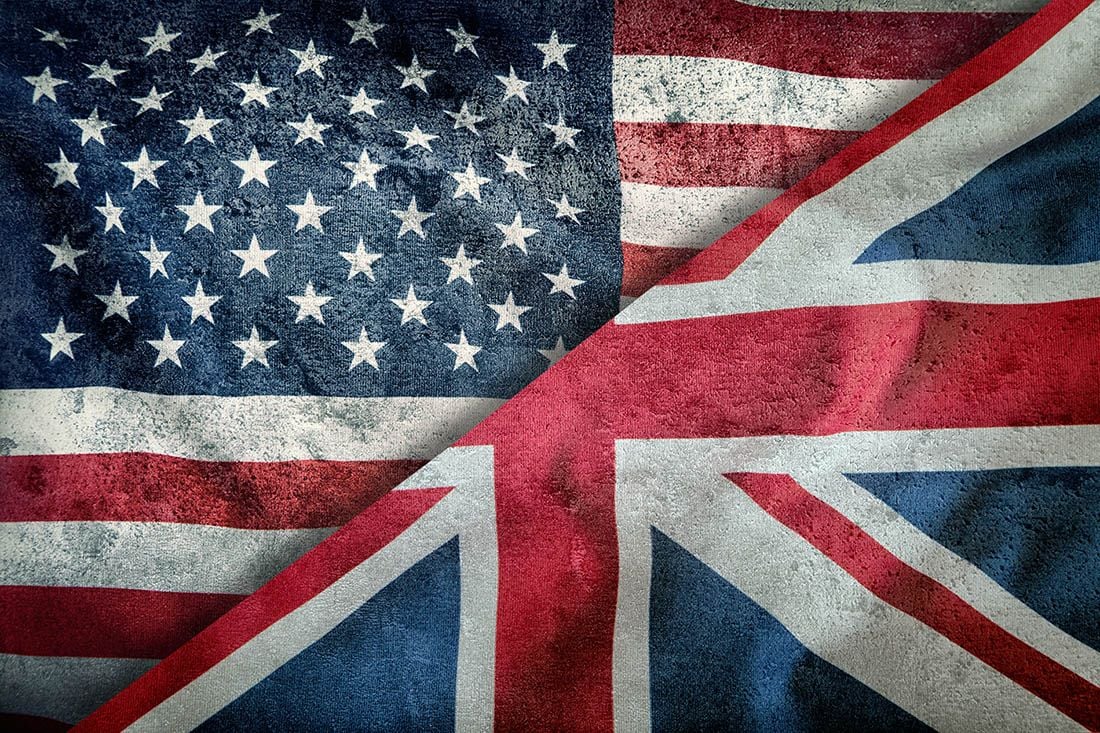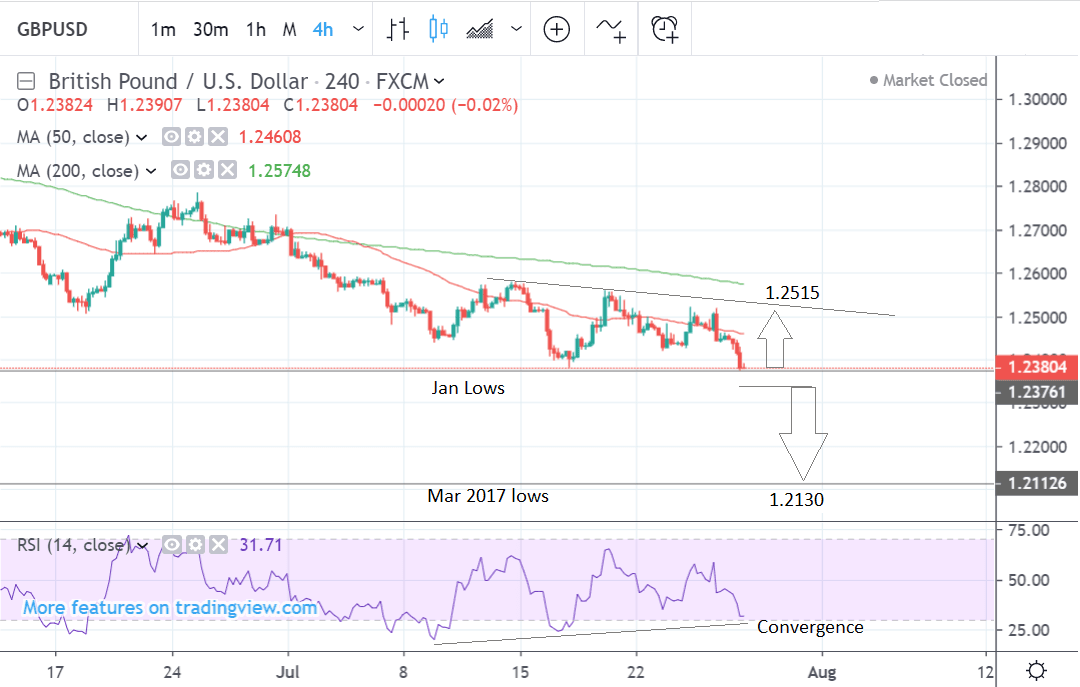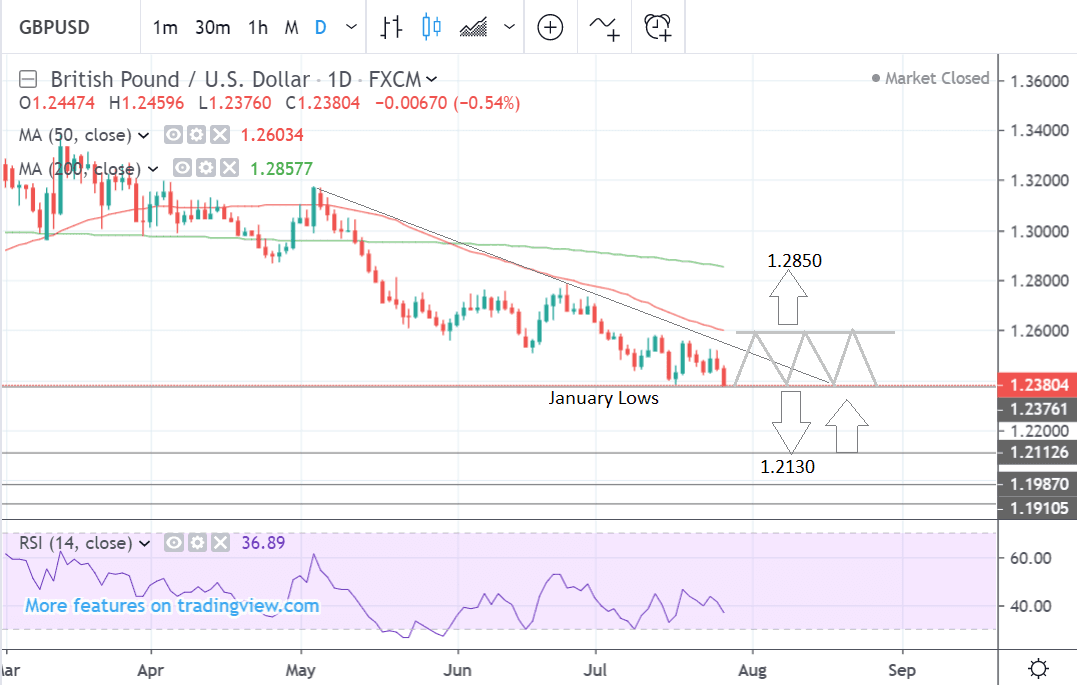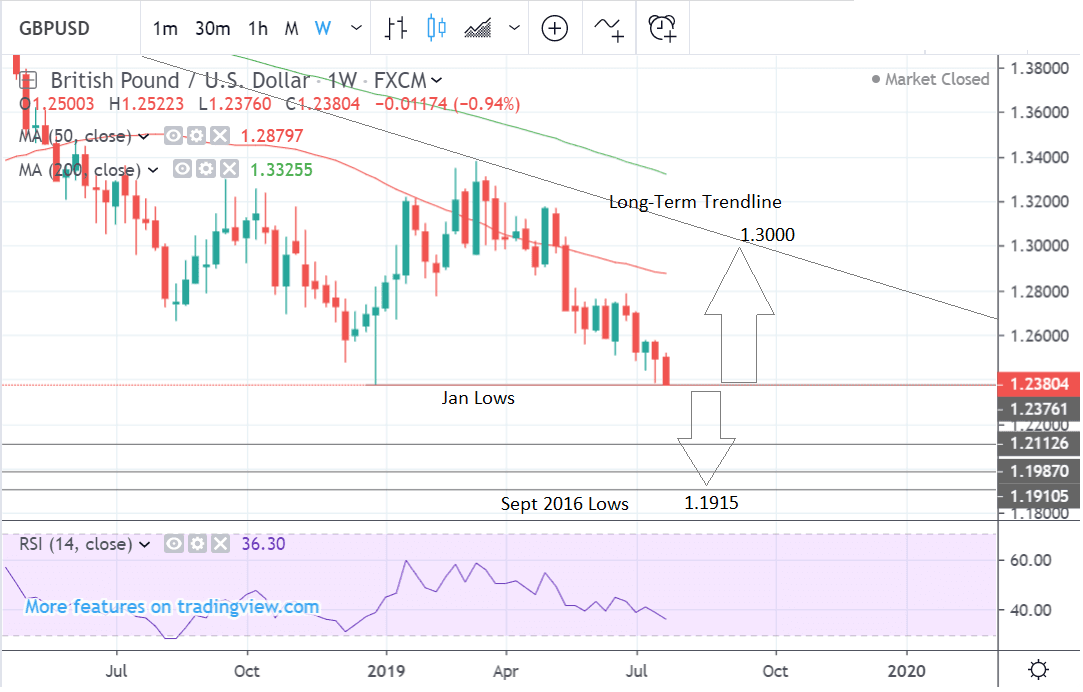Pound-to-Dollar Exchange Rate 5-Day Forecast: Testing Historic 'Hard' Floor, Fed Meeting in Focus

Image © Adobe Images
- GBP/USD trading on key January lows
- Potential for both move higher or break lower
- Pound to be moved by Brexit developments, PMIs & Bank of England
- Dollar eyes key Fed meeting
GBP/USD kicks off trade at around 1.2380 at the market open; having fallen almost 1.0% in the week prior.
Concerning the outlook, studies of the charts suggest the pair is at a crossroads with a 'hard' floor of support underpinning the British currency.
Technical studies suggest forces are evenly balanced and the pair could either bounce off the floor and trade sideways in the short-term or break lower in accordance with the dominant downtrend.
The 4-hour chart - used to determine the short-term outlook, which includes the next 5 days - shows the pair trading right on the January 2019 lows in the 1.23s.
This is the second time it has hit the January lows and the end result may either be a bounce like last time or the pair could break below the hard floor and accelerate its decline.
The established trend is down and this trumps all other considerations: there is an old saying that ‘the trend is your friend’ which means the established trend is expected to continue.
A break below the January lows, confirmed by a move below the 1.2350 level would indicate a probably continuation of the bear trend down to the next target at 1.2130.
However, at the same time the January lows have shown themselves to be a formidable obstacle (they are also the yearly lows) and this combined with the waning momentum which is now converging with price, albeit mildly, suggests the possibility of another bounce, back up to the trendline at 1.2515.
The daily chart shows how the trend could play out over the medium-term, which means the next week to month.
Again it is possible the pair could bounce off the hard floor provided by the January lows and start going sideways in a range between around 1.2380 and 1.2600. But as already noted, the established trend trumps all other considerations so a break below the January lows could see the exchange rate decline all the way down to 1.2130.
A deeper decline is unlikely as there are a lack of drivers over the medium-term which could push the Pound to those lows. Parliament, for example, is on holiday until the start of September, so there is unlikely to be any new market-moving news about Brexit during that time.
A break above the 50-day moving average (MA) at 1.2603, confirmed by a move above around 1.2625, could see the pair move up to a target at 1.2850 and the 200-day MA - but this not so likely for the same reason downside volatility is expected to be limited.
The weekly chart - used to give an idea of the longer-term outlook, which includes the next few months - is more likely to reflect future volatility as the Brexit deadline in October advances.
Anything is possible at this juncture and much depends on what happens at the current January lows. If the pair starts to recover then it could strike all the way up to a target at 1.3000 in the long-term at the level of a major multi-month trendline. This might be the technical scenario reflecting an easing in Brexit concerns over the next few months.
Alternatively, increased uncertainty could see a break below the January lows and more weakness thereafter, down to a longer-term target of the September 2016 lows at 1.1915. This might be the target should the outlook for Brexit worsen.
Time to move your money? Get 3-5% more currency than your bank would offer by using the services of foreign exchange specialists at RationalFX. A specialist broker can deliver you an exchange rate closer to the real market rate, thereby saving you substantial quantities of currency. Find out more here.
* Advertisement
The U.S. Dollar: Week Ahead Dominated by the Federal Reserve

The most important event for the U.S. Dollar in the week ahead is the Federal Reserve Open Market Committee Meeting (FOMC) at which it will decide whether or not to cut interest rates.
The meeting ends on Wednesday at 18.30 BST when the decision will be published.
This is important for the U.S. Dollar since interest rates can dictate the direction of the currency: the rule-of-thumb for currencies is that when a central bank cuts its interest rate the currency it issues falls.
To be more specific, when a central bank signals it will cut interest rates in the future the currency falls.
Markets are well positioned for a rate cut on Wednesday, therefore the rate cut itself is likely to be market neutral.
What matters is the signal the Fed gives as to future decisions: if the communication suggests more rates are likely than the market expects, then the Dollar will likely fall. If the Fed sounds a more upbeat tone, thereby hinting that it perhaps only one more cut is coming, the Dollar could instead rally.
The market is now a 100% certain the Fed will lower rates by at least 0.25% at the meeting on Wednesday (from 2.5% to 2.25%) and 21.4% that it will reduce rates by 0.50%, according to Fed funds futures pricing.
"A well-priced Fed and renewed expectations for a package of easing by the ECB suggest that the USD is more inclined to find itself on firmer footing," says Mazen Issa, Senior FX Strategist with TD Securities in New York.
On the 'hard' data front, the main data release for the U.S. Dollar is Non-Farm Payrolls in July, which is forecast to show a 170k rise in the number of new workers added when it is released on Friday at 13.30 BST.
Payrolls rebounded strongly in June after a disastrous month in May. They are now expected to settle down to a slightly lower level for the rest of 2019 as the global slowdown in manufacturing weighs.
“Even without a further escalation in the trade war, we expect a sub two-hundred trend for payrolls for the remainder of 2019 as uncertainty weighs on hiring. We expect employers added 170,000 net new jobs in July,” says Wells Fargo in their preview.
A big swing in payrolls could impact the Dollar since hiring is one of the areas of the economy most sensitive to slowdowns.
A poorer-than-expected result would weigh and a better-than-expected result support the Dollar.
The Pound: Brexit Headlines, Bank of England

Brexit sentiment is easily the most important driver of the Pound at present, and weekend headlines are unsupportive of the currency we belief.
Media reports suggest Prime Minister Boris Johnson has fully committed to a 'no deal' Brexit "by any means necessary".
The Sunday Times reports Johnson has set up a “war cabinet” to deliver Brexit “by any means necessary” by October 31 as a senior cabinet minister warned that there was “now a very real prospect” of no deal.
While markets have ramped up expectations for a 'no deal' Brexit since May, it is likely that there is further 'no deal' risk sentiment to be absorbed and therefore Sterling has the propensity to move lower and trigger fresh multi-month lows.
"Though we still see the risk of a no-deal Brexit at a fairly moderate 20%, we are bearish on Sterling over the short-term amid the expectation that Mr Johnson’s rhetoric towards the EU will remain belligerent and perhaps harden further still in the run-up to 31 October," says George Brown, an analyst at Investec.
On the calendar, the main event for the Pound next week is the Bank of England (BOE) rate meeting, since the BOE sets interest rates which are tier 1 driver of the Pound, however, in reality this may not be the case. Brexit uncertainty has paralysed the BOE and until it is resolved they are highly unlikely to take any action and all their guidance will be conditional on ‘a smooth Brexit’.
"Another possible trigger for sterling could be next Thursday’s Bank of England MPC decision, which is set to be accompanied by the quarterly Inflation Report. Our expectation is that the committee will vote to maintain the Bank rate at 0.75% unanimously (9-0) for the eighth meeting in succession," says Brown.
The current stance is still marginally hawkish due to upbeat wage growth and this sets the BOE apart from most of its G10 peers, with the exception of the bank of Canada. This should translate into pent up upside potential for the Pound should the UK achieve a managed Brexit.
However, as anyone who has been following developments in the new Boris Johnson administration this is far from certain. Johnson has gathered what looks increasingly like a ‘war cabinet’ of Brexiteer ministers who might be prepared to take the UK out of the EU with a 'no deal' Brexit on October 31.
“The Bank of England (BOE) continued to show a bias towards eventual tightening at its June meeting. This tightening is contingent on an eventual smooth exit from the European Union, however, an effort that has at times looked increasingly like a quixotic journey,” says Wells Fargo in a preview note on the meeting. “Inflation data have been stronger in the U.K. than in Europe, and according to the last statement “growth in unit wage costs has remained at target consistent levels.” “The U.K. economy has looked a bit more wobbly of late, particularly the manufacturing sector, which may be increasingly feeling the pressure from the factory sector struggles in continental Europe.”
The U.S. bank goes on to suggest ‘peer group pressure’ from other central banks turning increasingly dovish could be a further incentive for the BOE to turn dovish itself.
They forecast an eventual BOE rate hike not coming until 2020.
Given Manufacturing could be the weak link in the economy, the spot-light may be more closely trained on UK Manufacturing PMI data for July out on Thursday morning at 9.30 BST which is expected to show a decline to 47.7 from 48.0 previously.
A deeper-than-expected lapse as seen in European figures last week could spark weakness in the Pound, as it could be seen as the crack which could open up a wider slowdown.
Time to move your money? Get 3-5% more currency than your bank would offer by using the services of foreign exchange specialists at RationalFX. A specialist broker can deliver you an exchange rate closer to the real market rate, thereby saving you substantial quantities of currency. Find out more here.
* Advertisement







